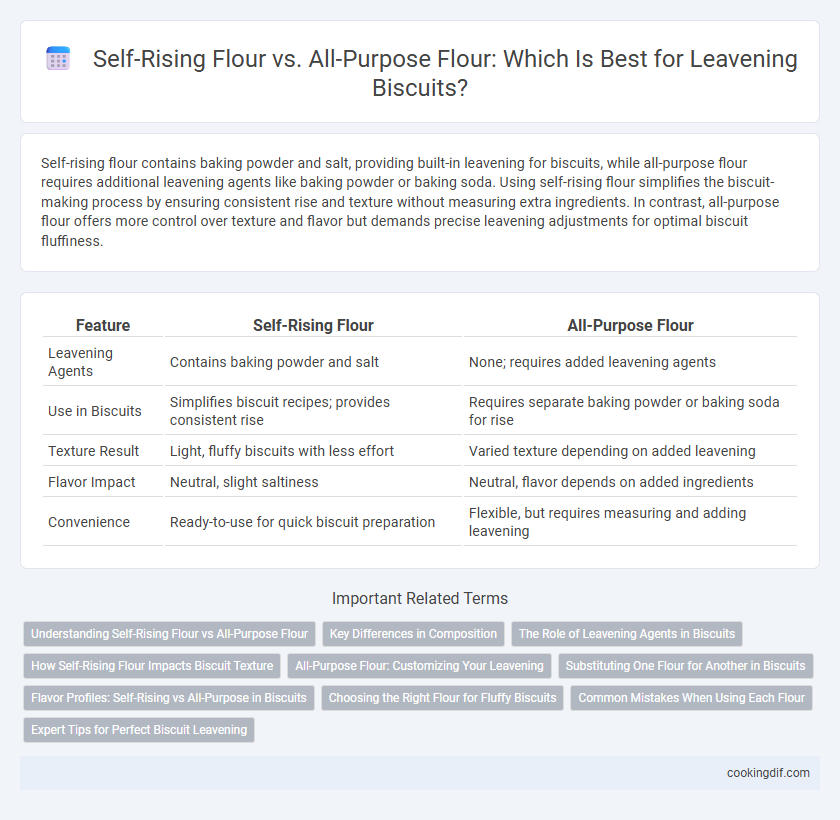Self-rising flour contains baking powder and salt, providing built-in leavening for biscuits, while all-purpose flour requires additional leavening agents like baking powder or baking soda. Using self-rising flour simplifies the biscuit-making process by ensuring consistent rise and texture without measuring extra ingredients. In contrast, all-purpose flour offers more control over texture and flavor but demands precise leavening adjustments for optimal biscuit fluffiness.
Table of Comparison
| Feature | Self-Rising Flour | All-Purpose Flour |
|---|---|---|
| Leavening Agents | Contains baking powder and salt | None; requires added leavening agents |
| Use in Biscuits | Simplifies biscuit recipes; provides consistent rise | Requires separate baking powder or baking soda for rise |
| Texture Result | Light, fluffy biscuits with less effort | Varied texture depending on added leavening |
| Flavor Impact | Neutral, slight saltiness | Neutral, flavor depends on added ingredients |
| Convenience | Ready-to-use for quick biscuit preparation | Flexible, but requires measuring and adding leavening |
Understanding Self-Rising Flour vs All-Purpose Flour
Self-rising flour contains a precise blend of flour, baking powder, and salt, which provides consistent leavening and convenience for biscuit recipes. All-purpose flour, lacking these additives, requires separate inclusion of leavening agents like baking powder or baking soda to achieve proper rise. Choosing self-rising flour simplifies the biscuit-making process and ensures uniform texture, while all-purpose flour offers versatility for customized leavening adjustments.
Key Differences in Composition
Self-rising flour contains a precise blend of flour, baking powder, and salt, providing built-in leavening agents that cause biscuits to rise without additional ingredients. All-purpose flour lacks these additives, requiring separate leavening agents such as baking powder or baking soda to ensure proper rise and texture. The presence of chemical leaveners in self-rising flour results in a more consistent rise, while all-purpose flour offers greater control over the biscuit's flavor and leavening intensity.
The Role of Leavening Agents in Biscuits
Self-rising flour contains baking powder and salt, providing built-in leavening essential for biscuits, while all-purpose flour requires separate leavening agents like baking powder or baking soda to achieve the desired rise. The chemical leaveners in self-rising flour release carbon dioxide during baking, creating light, fluffy biscuit textures. Choosing all-purpose flour allows precise control over leavening amounts, affecting biscuit height and crumb structure.
How Self-Rising Flour Impacts Biscuit Texture
Self-rising flour contains added leavening agents like baking powder and salt, which create a lighter and fluffier biscuit texture by providing consistent lift during baking. The pre-mixed leavening ensures uniform rise, resulting in biscuits with a tender crumb and airy structure. In contrast, using all-purpose flour requires separate leavening adjustments to achieve similar texture outcomes.
All-Purpose Flour: Customizing Your Leavening
All-purpose flour contains moderate protein levels, making it a versatile choice for biscuit recipes where leavening control is key. Unlike self-rising flour, all-purpose flour requires the addition of baking powder or baking soda, allowing precise customization of rise and texture. This flexibility enables bakers to adjust leavening agents and achieve the desired tender, flaky crumb in biscuits.
Substituting One Flour for Another in Biscuits
Self-rising flour contains baked-in baking powder and salt, providing consistent leavening for biscuits without extra ingredients, whereas all-purpose flour lacks these additives, requiring separate leavening agents like baking powder and salt to achieve the desired rise. Substituting self-rising with all-purpose flour necessitates precise measurements of baking powder--typically 1 1/2 teaspoons per cup of flour--and salt to mimic the self-rising blend, ensuring proper biscuit texture and lift. Using the wrong type or incorrect leavening quantities can result in dense or uneven biscuits, highlighting the importance of accurate substitution for light, fluffy biscuits.
Flavor Profiles: Self-Rising vs All-Purpose in Biscuits
Self-rising flour contains baking powder and salt, providing a light, tender texture with a mild tang in biscuits that enhances their flavor without additional leavening agents. All-purpose flour requires separate leavening additions like baking powder or baking soda, allowing more control over the biscuit's flavor profile, resulting in a richer, bolder taste depending on the leavening agents used. Choosing self-rising flour simplifies baking with a consistent, subtle flavor, while all-purpose flour offers versatility for customizing both texture and flavor depth in biscuits.
Choosing the Right Flour for Fluffy Biscuits
Self-rising flour contains baking powder and salt, enabling biscuits to rise without additional leavening agents, which simplifies the baking process and produces a tender, fluffy texture. All-purpose flour requires separate baking powder or baking soda to achieve similar leavening effects, offering more control over the biscuit's rise and flavor. Choosing self-rising flour ensures consistent fluffiness, while all-purpose flour provides customization for texture and taste in biscuit recipes.
Common Mistakes When Using Each Flour
Using self-rising flour in biscuit recipes can cause over-leavening due to its pre-added baking powder and salt, leading to dense or crumbly textures if not adjusted properly. Relying solely on all-purpose flour without adding a precise amount of leavening agents often results in flat, heavy biscuits lacking the desired rise. Misunderstanding the chemical makeup of each flour type is a common mistake that affects the texture and consistency of homemade biscuits.
Expert Tips for Perfect Biscuit Leavening
Self-rising flour contains baking powder and salt, providing consistent leavening results ideal for tender, fluffy biscuits. All-purpose flour requires adding the precise amount of baking powder and salt to achieve similar rise and texture. Expert tips highlight sifting dry ingredients together and avoiding overmixing the dough to maximize biscuit leavening and tenderness.
Self-rising flour vs All-purpose flour for leavening Infographic

 cookingdif.com
cookingdif.com